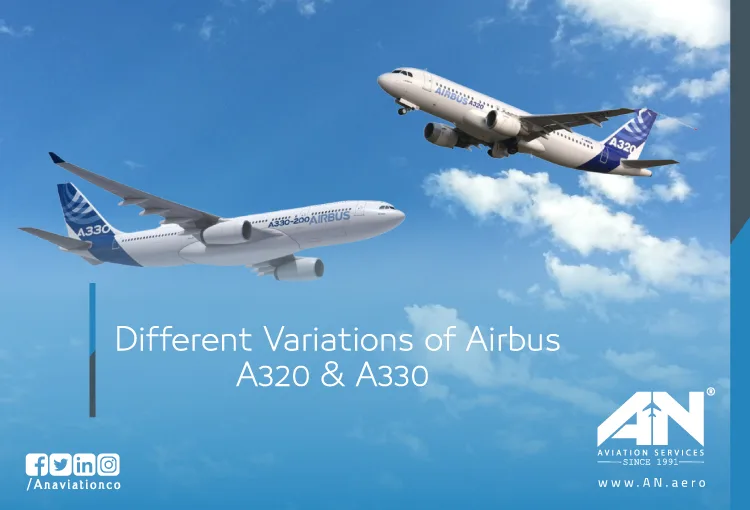
The Airbus A320 and A330 families have long been central to the success of commercial aviation. Both aircraft represent innovation in their respective categories, offering unmatched performance, fuel efficiency, and adaptability. While the A320 is known as the backbone of short-haul routes, the A330 is celebrated for its dominance in medium- to long-haul markets. In this blog, we’ll dive into the differences and variations within the A320 family and the A330 lineup, exploring how they cater to diverse aviation needs.
A Quick Overview: A320 vs A330
The Airbus A320 is a narrow-body, single-aisle aircraft designed for short to medium-haul routes, while the Airbus A330 is a wide-body airliner capable of carrying more passengers and cargo over longer distances. Both are lauded for their fuel-efficient designs and adaptability, but they serve distinctly different purposes in the airline industry.
The Airbus A320 Family
Introduced in 1988, the A320 family revolutionized commercial aviation with its advanced fly-by-wire system and cost-efficient operations. Over the years, Airbus has expanded the family with various models tailored to airlines’ needs.
Variations in the A320 Family:
A320 Original:
The classic A320, which entered service in the late 1980s, quickly became a favorite for short- to medium-haul routes. With a typical seating capacity of 150–180 passengers, it provided an ideal solution for domestic and regional flights.
A318:
The smallest member of the A320 family, the A318, seats up to 132 passengers. Though it shares much of the same technology as its larger siblings, it was designed for markets with lower passenger demand or smaller airports.
A319:
A slightly larger variant than the A318, the A319 can carry up to 156 passengers. This model is popular for routes requiring more range than the A320 while still maintaining the efficiency of a narrow-body jet.
A321:
The largest of the A320 family, the A321 offers extended range and capacity, accommodating up to 244 passengers in some configurations. Airlines use it for longer domestic and international routes.
A320neo Series:
The New Engine Option (neo) series brought significant improvements to the A320 family, including advanced Pratt & Whitney and CFM International engine options. The A320neo variants offer greater fuel efficiency, reduced emissions, and quieter operations.
The Airbus A330 Family
The Airbus A330 is a versatile wide-body airliner that first entered service in the early 1990s. Known for its ability to balance cost-efficiency with passenger comfort, the A330 has become a favorite for long-haul routes.
Variations in the A330 Family:
A330-200:
A shorter, longer-range version of the A330, this model is designed for airlines seeking to carry fewer passengers while covering more distance. It’s commonly used for transatlantic flights and operates with excellent fuel efficiency.
A330-300:
The original variant of the A330, the A330-300, features a longer fuselage and greater passenger capacity. It’s ideal for routes with high demand and medium to long-haul distances.
A330neo:
Similar to the A320neo, the A330neo (New Engine Option) series features advanced Rolls-Royce Trent 7000 engines, which provide exceptional fuel efficiency and range. These updates make the A330neo a sustainable choice for airlines aiming to reduce operational costs and carbon emissions.
Key Differences Between the A320 and A330 Families
1- Aircraft Size:
The A320 is a narrow-body aircraft with a single aisle, designed for short-haul flights. In contrast, the A330 is a wide-body airliner with twin aisles, suitable for longer journeys and higher passenger loads.
2- Range:
While the A320 family is typically used for domestic and regional routes, the A330 excels on intercontinental routes thanks to its greater fuel capacity and aerodynamic design.
3- Passenger Capacity:
The A320 family can accommodate anywhere from 100 to 240 passengers, depending on the variant. The A330, on the other hand, typically seats 250 to 440 passengers, making it ideal for high-demand routes.
4- Engine Options:
The A320 family features engine choices from Pratt & Whitney and CFM International, while the A330 relies heavily on Rolls-Royce engines, particularly in its neo variants.
5- Mission Profiles:
Airlines use the A320 for quick turnarounds, domestic flights, and shorter international journeys. The A330 is better suited for longer routes, such as transcontinental or transoceanic flights.
Why Airlines Choose Airbus A320 & A330?
Both the A320 and A330 families are renowned for their efficiency and reliability. Airlines often select the A320 for its low operating costs and versatility in serving high-frequency routes. Meanwhile, the A330 is favored for its ability to move large numbers of passengers over long distances with optimal fuel usage.
Additionally, the commonality in Airbus designs makes it easier for airlines to train crews and maintain fleets, further enhancing their appeal.
Innovations in Both Aircraft Families
- Fuel Efficiency: Both families continue to set benchmarks for fuel-efficient operations, thanks to innovative designs and advanced engine technologies.
- Comfort: From the A320neo’s quieter cabins to the A330’s spacious interiors, both families prioritize passenger comfort.
- Sustainability: With modern variants such as the A320neo and A330neo, Airbus is helping airlines reduce their carbon footprints while maintaining profitability.
Conclusion
Whether it’s the short-haul efficiency of the A320 family or the long-haul dominance of the A330, Airbus continues to deliver solutions that meet the evolving needs of the aviation industry. Both families have proven their worth over decades of service, and their continued innovation ensures they remain central to modern air travel.
For passengers and airlines alike, the choice between an A320 or A330 ultimately comes down to the journey’s length, capacity requirements, and operational efficiency. What remains constant, however, is the reliability and quality associated with these iconic Airbus aircraft.

